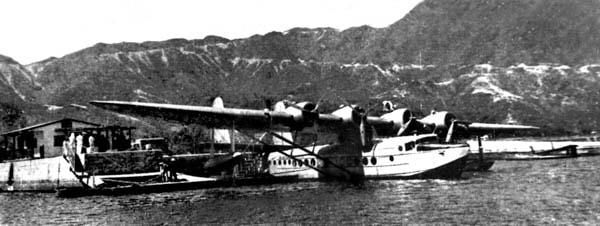In 1911, Charles Van den Born, a Belgian pilot, arrived in Hong Kong to host a flight display in Sha Tin. This marked the beginning of aviation history in Hong Kong. Following the display, others flew to Hong Kong to host similar aeronautical events and exhibitions. However, none of them was sufficient to arouse the interest of either the government or the people of Hong Kong in aviation. At that time, there was no aerodrome in Hong Kong, and pilots could only land on abandoned lots in the New Territories or on the beaches in the south of Hong Kong Island.[43]
In the 1920s, there was a breakthrough in the development of aviation in Hong Kong. In 1916, the Kai Tack Land Investment Company Limited started a reclamation project in Kowloon Bay for the construction of a residential estate. However, due to financial problems and the strike-cum-boycott in 1925, the progress of reclamation and the building of the residential estate slowed to a crawl, resulting in a large open area of unused land. As the lot was near the sea and far away from residential areas, it was considered suitable to be used as an aerodrome. In 1924, Harry Abbott from the United States started to use the area as a landing field. He rented the lot from the Kai Tack Land Investment Company Limited, and established the Abbott School of Aviation. Even though his venture eventually failed, both the government and the citizens of Hong Kong then recognised the lot as being suitable for aviation.
In 1925, the Royal Navy aircraft carrier HMS Hermes visited Hong Kong and rented the shoreline of the Kai Tak lot as a support station. During its stationing in Hong Kong, the HMS Hermes helped the colonial government to monitor the strike-cum-boycott, and thus brought the colonial government to appreciate the importance of having an air base in Hong Kong. The colonial government sent a request through the Colonial Office to the Committee of Imperial Defence for permission to build an air base. As the Washington Agreement forbade Britain from building any military base beyond the eastern longitude of Singapore, the Committee of Imperial Defence immediately turned down the request. Despite this, the Air Ministry confirmed that the Kai Tak lot was a suitable location and asked the colonial government to try to reserve the land for facilitating the construction of an air base whenever it proved necessary.[44]
In 1927, the British government eventually decided to build a Royal Air Force base in Hong Kong. This was due partly to the political instability in China, which threatened British rule in the Colony. Additionally, Japan had broken the Washington Agreement by building an air base in southern Taiwan. As seaplanes were commonly used during the 1920s, the Air Ministry, the Colonial Office and the colonial government agreed that the Kai Tak lot was the only suitable site for an air base in Hong Kong. Therefore, the government negotiated with the Kai Tack Land Investment Company Limited and finally bought the lot from it. The Royal Air Force base was immediately set up in 1927. As there was a lack of financial support from the British government, the colonial government took a long time to raise revenue for the completion of the reclamation project, as well as for building the airport’s basic facilities. By 1929, the colonial government had completed most of the infrastructure works of Kai Tak Airport. The airport served as both a military and a civil airport. The government appointed the Harbour Master as the Director of Air Services in 1929. The two possible reasons for appointing the Harbour Master to oversee the air services were that he was in charge of emigration and immigration matters and seaplanes, the predominant kind of aircraft using Kai Tak Airport. The Harbour Master’s Department had, indeed, been involved in arranging suitable areas for seaplanes to land. In the following year, the Directorate of Air Services was set up and associated with the Harbour Master’s Department. The Harbour Master’s Department was renamed the Harbour Department and Directorate of Air Services. Albert James Robert Moss was appointed the Superintendent of Aerodrome to manage and develop the airport.[45]
From 1931 to 1940, the Director of Air Services improved the standard of the airport facilities. In 1932, the surface of the airport was levelled, and the hangar and annex were completed. In 1936, the new civil hangar and administration block were completed, and the the civil airport was expanded to the western end of Kai Tak. The improvement of the airport facilities attracted more airlines to Hong Kong. Imperial Airways inaugurated a weekly service from Australia to Hong Kong via Penang in 1935. China National Aviation Corporation inaugurated a weekly service from Shanghai to Hong Kong via Guangdong in 1936. Pan American Airways and Eurasia Aviation Corporation inaugurated a weekly service from San Francisco to Hong Kong and from Beijing to Hong Kong in 1937 respectively. With support from the government, the Far East Flying Training School was set up in 1934 to train pilots and engineers. As there was rapid development in the local aviation industry, the Far East Flying Training School was expanded in 1936 and subdivided into a flying section and an engineering section.[46]
Notes:
- [43]宋軒麟:《香港航空百年》(香港:三聯書店(香港)有限公司,2002),頁10-18。
- [44]宋軒麟:《香港航空百年》,頁10-26; Charles Edward James Eather, Airport of the Nine Dragons: Kai Tak, Kowloon (Surfers Paradise : ChingChic Publishers, 1996), pp. 9-19; 宋軒麟:〈九龍城地標之二:啟德濱與啟德機場的興建〉,載於趙雨樂及鍾寶賢:《九龍城》(香港:三聯書店(香港)有限公司,2001),頁170-175。
- [45]宋軒麟:《香港航空百年》,頁25-49; Eather, pp. 20-42; 宋軒麟:〈九龍城地標之二:啟德濱與啟德機場的興建〉,載於趙雨樂及鍾寶賢:《九龍城》,頁174-182。
- [46]Reports of the Harbour Master and Director of Air Services, 1930-1939 ; 宋軒麟:〈九龍城地標之二:啟德濱與啟德機場的興建〉,載於趙雨樂及鍾寶賢:《九龍城》,頁174-184。



